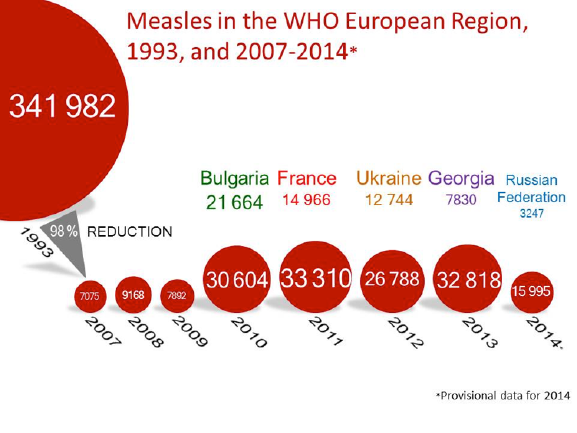 The American media is ablaze with stories of a major measles outbreak. But Berlin alonehad more measles cases last month than the US.
The American media is ablaze with stories of a major measles outbreak. But Berlin alonehad more measles cases last month than the US.
This is not to downplay the seriousness of what is happening in the US but should make us wonder why we are not reading headings about our own epidemics.
Berlin has a population of 3.5 million people and reported 254 cases in January 2015. The US has a population of 316 million and reported 104 cases in the same month.
You already knew about the US outbreak but had you heard about Berlin?
The outbreak in Germany began late last year but has not attracted the same global attention as those in the US. You may also have missed:
- last year’s outbreak at an international event in Slovenia
- 123 cases in Serbia between November 2014 and January 2015
- 500 cases in Kyrgyzstan since December 2014
- 3,426 cases in the Federation of Bosnia and Herzegovina (mostly in adolescents) last year
- 1,008 reported cases in Republika Srpska (mostly in young adults) in 2014
- Ongoing outbreaks in China, Sudan, Papua New Guinea and elsewhere
See European Centre for Disease Prevention and Control (ECDC) for more and check out their interactive Measles Atlas showing measles vaccine uptake
Suffice to say the chances of Europe meeting its goal of eliminating measles and rubella by 2015 are exceedingly slim.
WHO data for the European Region (which includes 53 nations spread across the continent) shows that there were 341,982 measles cases in 1993. This had fallen by 98% by 2007 when where were just 7,000 cases in total.
But the number has never been as low as that since. Indeed, since 2010 we have not seen a year with fewer than 15,000 cases.

And what is Europe doing about it? Where’s the sense of outrage, of urgency, of crisis?
Read Measles: Europe’s shameful export
Back in the US, 24-hour news channels, blogs and newspapers are interviewing experts, parents and politicians. They want to know this happened and how it will be fixed.
Barack Obama is urging parents to vaccinate their kids, Hilary Clinton used Twitter to voice her support and (with the odd exception) other wannabe US presidential candidates are lining up to praise immunisation.
The science is clear: The earth is round, the sky is blue, and #vaccineswork. Let’s protect all our kids. #GrandmothersKnowBest
— Hillary Clinton (@HillaryClinton) 3 Février 2015
Read: Measles in Disneyland: An American Tragedy
Europe’s leaders are less forthright when it comes to ensuring high levels of vaccine uptake.
Yes, German Chancellor Angela Merkel hosted a GAVI conference at which her Development Minister said failure to reduce child mortality was ‘a scandal’. But nothing on the scandal of parents who have access to free vaccination and opt out, allowing a preventable disease to circulate in Berlin.
The media here in Europe remain largely unmoved by local measles outbreaks, but join the chorus of headlines on the Disneyland epidemic.
Even in France, you’ll find headlines about tens of cases in California. This is the same France where, despite tens of thousands of cases over the past five years, there is no outcry when local authorities neglect to report data on vaccine uptake.
Proportional response
So why does a US measles epidemic make more headlines than those in Europe and elsewhere?
Allow me to speculate on a few of the possibilities. The first is to do with language, culture and media structures. In Europe, we know a lot about what happens in the US because we consume US media which is usually in English. Slovenian epidemics are unlikely to make the same global impact as a few dozen cases in Arizona.
The Disneyland outbreak made typical families in the US (and elsewhere) feel vulnerable. ‘Normal’ kids on a normal holiday were infected and infected others. It could happen to anyone.
Maybe – maybe – in Europe we let ourselves off the hook by pinning measles outbreaks on distinct sub-sections of the population. (Read Marc Muscat’s Who Gets Measles in Europe).
Thousands of cases in Bulgaria and Romania were largely concentrated in Roma communities; the 17-year-old girl who died from measles in the Netherlands last year lived in the Dutch ‘Bible belt’ where vaccination rates are low; and epidemics have been reported in anthroposophic communities.
Perhaps headline writers (and their readers) don’t see these groups as ‘typical’. They are not the ‘normal families’ on holiday in Disneyland.
Of course, these groups all deserve protection and when they opt out of recommended immunisations have an impact on wider public health.
Then there is the fact that the US had been measles-free for a decade before losing its grip on the disease. This reversal is genuinely newsworthy and a warning for everyone: even if we defeat measles, complacency can lead to its return (unless, like smallpox, it is eradicated globally).
The American way
The US outbreak has at least given some pointers on how to contain measles. First they were a good example on elimination. Now let’s hope the US will become a success story on how to handle its resurgence.
There are signs of a more sophisticated approach to communicating with different types of parents who resist or question vaccination. The role of vaccine advocates – from doctors and nurses to pro-vaccination parents and politicians – will also be important to observe if Europe wants to wipe out measles and other vaccine-preventable diseases.
Read: Where are Europe’s vaccine advocates?
And there are lessons to learn from elsewhere too. South America has been measles-free for more than a decade and Australia has had considerable success in raising immunisation rates, even among disadvantaged communities and those with so-called alternative lifestyles.
There is plenty to learn from if we want to. For a start, we need to get upset about the apathy shown by our leaders, our media and our neighbours.





Slovenian citizen
January 20th, 2016
You know what is really shocking about Slovenian outbrake? That many of the infected were vaccinated. Report on that.
You know what is also shocking about Bosnian outbrakes? They report no serious consequences for those infected. WIKIPEDIA says: “In developed countries, death occurs in 1 to 2 cases out of every 1,000”. Therefore we should have around 5-10 deaths alone in Bosnia. Where are they?
This one-way data really irks me. Regarding ’93 – ’07 data, the vaccination rates are missing. Herd immunity is the biggest reason for vaccination. To claim that you need the vaccination rates in order to make a link. If link is “broken” anywhere in that data span, then we have a reasonable doubt.
It’s always the lack of info that causes problems. Or selective reporting, if you wish.
And you know what isn’t shocking about reporting about measles? Because there’s nothing shocking to report about. If we had at least 10 deaths in Bosnia, well… that’d be news. But the whole problem with this is that we’d reveal vaccinated get infected, too. If a country wants to keep the herd immunity at a certain rate, it shouldn’t stir the mud.
Sest
July 21st, 2017
Nice Slovenian Citizen. It’s really chaps my hide the reporting on vaccination is so blatantly inept.
Slovenian citizen
January 20th, 2016
One another thingy. Herd immunity should be at 95% says WHO. In Austria they have it at 76% (source: http://data.worldbank.org/indicator/SH.IMM.MEAS) which should mean they should have outbreaks unseen in EU and anywhere else in developed world.
What the heck went wrong there? Where are the massive outbreaks?! I find that shocking.
Gary Finnegan
January 27th, 2016
Hi Slovenian citizen. We have addressed your question in the past.
‘Why do some vaccinated kids still get sick’
https://www.vaccinestoday.eu/stories/why-do-some-vaccinated-kids-still-get-sick/
Pingback
April 24th, 2017
[…] views on lifestyle, education and medicine, as well as among some religious groups. These subgroups may better explain the recent outbreaks of measles in Europe than a widespread anti-vaccination […]
Patricia A Penner
July 26th, 2017
Berlin has a population of 3.5 million people and reported 254 cases in January 2015. The US has a population of 316 million and reported 104 cases in the same month.
these numbers do not equate to an epidemic IN ANY WAY!!!!!!!!!!!!!!!!!!!!